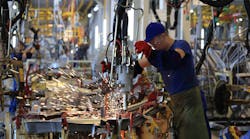Download this article in PDF format.
They may be dealing with long lead times for raw materials, ongoing economic uncertainty and a global pandemic that’s showing no real signs of ending yet, but none of that has stopped American manufacturers from posting their fifth straight month of economic growth.
According to the latest “Manufacturing ISM Report on Business,” economic activity in the manufacturing sector grew in September, with the overall economy notching a fifth consecutive month of growth.
"The September PMI registered 55.4%, down 0.6 percentage point from the August reading of 56%,” ISM’s Timothy R. Fiore said in the press release. “This figure indicates expansion in the overall economy for the fifth month in a row after a contraction in April, which ended a period of 131 consecutive months of growth.”
According to ISM, a PMI above 42.8%, over a period of time, generally indicates an expansion of the overall economy. Therefore, the September PMI indicates the overall economy grew in September for the fifth consecutive month following contraction in April. “The past relationship between the PMI and the overall economy indicates that the PMI for September (55.4%) corresponds to a 3.7% increase in real gross domestic product (GDP) on an annualized basis,” Fiore pointed out.
Key Findings
Some of ISM’s key findings include:
- The New Orders Index registered 60.2%, a decrease of 7.4 percentage points from the August reading of 67.6%.
- The Production Index registered 61%, down 2.3 percentage points compared to the August reading of 63.3%.
- The Backlog of Orders Index registered 55.2%, 0.6 percentage point higher compared to the August reading of 54.6%.
- The Employment Index registered 49.6%, an increase of 3.2 percentage points from the August reading of 46.4 percent.
- The Supplier Deliveries Index registered 59%, up 0.8 percentage point from the August figure of 58.2%.
"After the coronavirus (COVID-19) pandemic brought manufacturing activity to historic lows, the sector continued its recovery in September,” Fiore said, noting that the companies that participated in the survey (and their suppliers) made up a panel that continues to operate in reconfigured factories and is becoming more proficient at maintaining output.
“Panel sentiment was optimistic (2.3 positive comments for every cautious comment),” he added, “an improvement compared to August.” Among the six biggest manufacturing industries, food, beverage & tobacco products remains the best-performing sector, with fabricated metal products and chemical products also growing. Computer & electronic products and transportation equipment expanded moderately, ISM reports, while petroleum & coal products continued to struggle.
Straight From the Horse’s Mouth
While U.S. manufacturing as a whole appears to be successfully shaking off the impacts of the global pandemic, individual companies and procurement officers are still facing challenges. In particular, procuring goods needed to make end products appears to be a major roadblock for many respondents.
“[We’re] still struggling with long lead times for components coming from China contract manufacturers,” one panel member in the computer and electronics sector told ISM. "Business is booming, and the supply chain has been caught off guard,” one professional in the transportation equipment industry revealed. “We are working closely with our suppliers to ensure supply and try to control costs. The resin industry, along with plastics, is driving cost increases and scarce availability.”
"Overall business conditions are improving, but not at the rates we saw them decline,” said a respondent working in the fabricated metal products sector. "Retail sales remain strong, but food service is still down about 15 percent year-over-year,” a panel member from the food, beverage, and tobacco products sector added. “All of our factories are still struggling with manning shifts due to positive COVID-19 cases and/or quarantine because employees came in contact with someone who contracted the virus."










